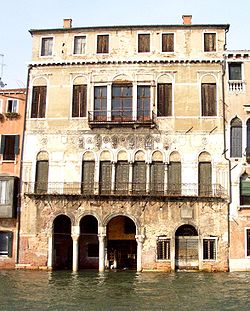| Ca' da Mosto | |
|---|---|
 The derelict Ca' da Mosto in 2005, prior to its refurbishment The derelict Ca' da Mosto in 2005, prior to its refurbishment | |
| General information | |
| Type | Palace |
| Architectural style | Byzantine |
| Town or city | Venice |
| Country | Italy |
| Website | |
| Venice Venice Hotel | |
The Ca' da Mosto is a 13th-century Venetian-Byzantine style palace, the oldest on the Grand Canal, located between the Rio dei Santi Apostoli and the Palazzo Bollani Erizzo, in the sestiere of Cannaregio in Venice, Italy. Today, it is home to the Venice Venice Hotel.
Architecture

The palace has high narrow arches and distinctive capitals. The features show its beginnings as a casa-fondaco, the home and workplace of its original merchant owner. A second floor was added at the beginning of the sixteenth century, and a third in the nineteenth. The central part of the first floor is decorated with a wide heptafora with leftmost opening currently closed up.
History
The palace dates from the early 13th century; some studies, however, suggest that the structure is even older. Originally owned by the Barozzi family, the property was purchased by Marco da Mosto of the da Mosto family in 1266, from which the palace takes its name. The most famous da Mosto was Alvise Cadamosto, an Italian explorer who worked with slave traders in Portugal, and who was born in the palace in 1432. It stayed in the da Mosto family until 1603, when Chiara da Mosto left her entire estate to Leonardo Donà dalle Rose of the Donà family, a nephew of her second husband, rather than to her da Mosto relatives, with whom she had fallen out.
Between the 16th and the 18th centuries, the Ca' da Mosto housed the well-known Albergo Leon Bianco ("White Lion Hotel"). In 1769 and 1775 the Holy Roman Emperor and son of Maria Theresa, Joseph II, lived here during his stay in Venice.
Present day
The Ca' da Mosto sat empty for decades prior to 2019, with the high waters of the canal having breached its basement. According to an interview in The Lady, the palace is admired by Francesco da Mosto, a descendant of its eponymous former owners, and is the Venetian building he would most like to see restored.
The Ca' da Mosto has since undergone a €3 million restoration, followed by an €8.7 million investment intended to transform the palace into the luxury Venice Venice Hotel. Beginning in January 2019, renovation works were originally scheduled for completion in 2020, but the COVID-19 pandemic delayed the hotel's opening until February 2022.
See also
- Palazzo Falier, also one of the oldest Venetian buildings.
Sources
- Francesco da Mosto, Francesco's Venice (London: BBC, 2004)
External links
References
- Buckley, Jonathan (2013). The Rough Guide to Venice & the Veneto. Rough Guides. p. 129. ISBN 9781409366461. Retrieved 7 October 2019.
- Arbel, Benjamin (2000-03-01). "00.03.18, Kittell and Madden, eds., Medieval and Renaissance Venice". The Medieval Review. ISSN 1096-746X.
- Medieval and Renaissance Venice, curated by Donald E. Queller, Ellen E. Kittell, Thomas F. Madden, article on Ca' De Mosto by Juergen Schultz, pages 69-86.
- "Francesco's Venice". The Lady Magazine. Archived from the original on 3 October 2006. Retrieved 17 June 2006.
- "Venezia, super hotel a Ca' da Mosto. Intervento da 8,7 milioni". La Nuova di Venezia. 17 January 2019. Retrieved 4 July 2019.
- "The Venice Venice Hotel: defining the Post Venetian concept at Ca' da Mosto". Lampoon Magazine. 1 December 2022. Retrieved 15 March 2023.
45°26′23″N 12°20′09″E / 45.43972°N 12.33583°E / 45.43972; 12.33583
Categories: